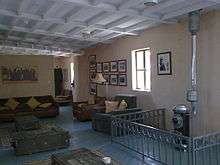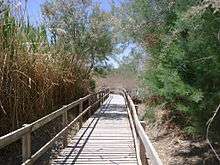Azraq Wetland Reserve
The Azraq Wetland Reserve is a nature reserve located near the town of Azraq in the eastern desert of Jordan. An oasis for migratory birds, Azraq was established in 1978 and covers 12 square kilometres (4.6 sq mi). The natural springs dried up in 1992 and most migratory birds subsequently moved away from the area. Artificial springs are maintained today in order to keep the site a tourist destination.
| Azraq Wetland Reserve | |
|---|---|
 The wetlands at Azraq. | |
| Nearest city | Azraq |
| Area | 12 square kilometres (4.6 sq mi)[1] |
| Established | 1978 |
| Governing body | Royal Society for the Conservation of Nature |
| Official name | Azraq Oasis |
| Designated | 10 January 1977 |
| Reference no. | 135[2] |
History
The wetlands were created some 250,000 years ago[3] as a result of being fed by aquifers that corresponded with geological changes. Azraq has, since ancient times, been the crossroads of both human trade routes and bird migrations.[4] Millions of cubic meters of freshwater attracted camels caravans[5] carrying spices and herbs traveling between Arabia, Mesopotamia, and Syria.[3] Millions of migrating birds stopped in Azraq between Africa and Europe.[4] However, in the 1960s, water began to be pumped to support Amman's booming population.[5] In 1978, the Royal Society for the Conservation of Nature established Azraq as a wetlands reserve.[6] By 1992, however, the springs dried up,[5] and the aquifers that had once gushed ceased to provide. All the water buffalos of Azraq died, and many migrating birds went to the Sea of Galilee instead.[5]
Azraq today
The Azraq wetlands have been described as in the state of "ecological collapse".[5] RSCN continues to fight an uphill battle against rising population and a growing demand for water.[5] The 10,000,000 cubic metres (353,146,667 cu ft) of water per year provided by the Jordanian Ministry of Water to maintain Azraq is only sufficient to restore Azraq to 10% of its original size.[7] Today, there are more than 500 illegal wells still pumping water from Azraq.[8] In just 37 years the numbers of migrant birds have reduced from 347,000 on February 2, 1967 to 1200 birds on February 2, 2000.[9] Azraq provides drinking water for one-quarter of Amman.[10] 25 square kilometres (9.7 sq mi) once covered by wetlands have now dried up.[6]
Accommodation
RSCN maintains an Azraq Lodge several kilometers away from the wetlands[5] which features a gift shop, restaurant, 16 rooms in a 1940s British military hospital,[11] and a reception area.

Trails and activities

The Marsh Trail is a raised platform going through the reserve that is approximately 1.5 kilometres (0.93 mi).[11] Sections of the trail are on land going through the reeds. Halfway through the trail is the mud-brick "rustic bird hide", overlooking one of the reserve's lagoons, which is used for bird watching
.[11]
Wildlife
Migratory birds come from Anatolia, Scandinavia, Siberia, and Africa, stopping in Azraq during the long journey.[12] The partial restoration of the wetlands by RSCN have resulted in the return of several migratory species, such as the hoopoe lark, Cetti's warbler, the desert finch, and the marsh harrier.[11] Among the 280 recorded migratory species in Azraq are the ruff, avocet, little stint, and the little ringed plover.[11] Additionally, several birds of prey stop in Azraq, such as the European honey buzzard and Montagu's harrier.[11]
Prehistoric Wildlife
From ancient times, Azraq, ecologically, was a continuation of Africa.[13] In this time period, many animals often characterized as African lived in Azraq.[14] Among these species were the Syrian wild ass, wild camel, rhinoceros, hippopotamus, Asian elephant, gazelle, aurochs, Asiatic cheetah, Syrian ostrich, Asiatic lion, and Arabian oryx.[14] All of these animals, except the gazelle, are now extinct in Azraq, and Jordan alike.[14]
See also
- Dana Biosphere Reserve
- Wadi Mujib
- Wadi Rum
- Dibeen Forest Reserve
- Shaumari Wildlife Reserve
- Royal Society for the Conservation of Nature
- List of nature reserves in Jordan
References
- "Reserves of Azraq and Shaumari". Archived from the original on 2009-05-03. Retrieved 2009-04-19.
- "Azraq Oasis". Ramsar Sites Information Service. Archived from the original on 23 October 2015. Retrieved 25 April 2018.
- Poster in the Azraq museum.
- Poster in the Azraq museum.
- Matthew Teller. Rough Guide to Jordan. Rough Guides 2007.
- "Azraq Wetlands Reserve". Archived from the original on 2008-06-24. Retrieved 2008-04-18.
- Poster in the Azraq museum.
- Poster in the Azraq museum.
- Poster at the Azraq museum.
- Poster in the Azraq museum.
- Azraq Wetlands Reserve & Lodge brochure. RSCN/Wild Jordan.
- Map in the Azraq museum.
- Poster at the Azraq museum.
- Poster at the Azraq Museum.
External links
| Wikimedia Commons has media related to Azraq Wetland Reserve. |
- Royal Society for the Conservation of Nature
- Wheel shapes near Azraq Oasis, visible only from the air